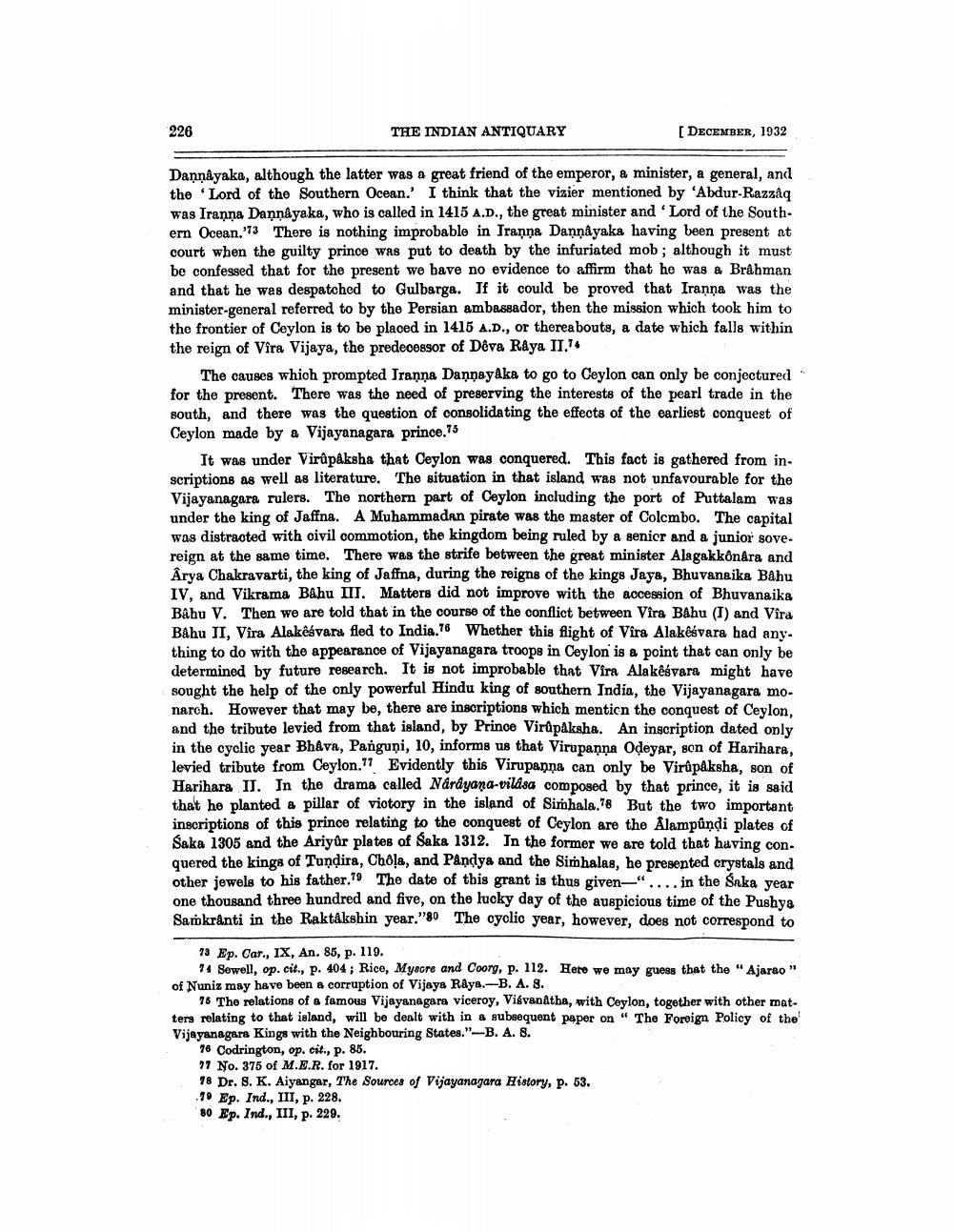________________
226
THE INDIAN ANTIQUARY
[ DECEMBER, 1932
Dannayaka, although the latter was a great friend of the emperor, & minister, a general, and the Lord of the Southern Ocean. I think that the vizier mentioned by 'Abdur-Razzaq was Iranna Dannayaka, who is called in 1415 A.D., the great minister and 'Lord of the South. ern Ocean.'73 There is nothing improbable in Tranna Dannayaka having been present at court when the guilty prince was put to death by the infuriated mob; although it must be confessed that for the present we have no evidence to affirm that he was a Brahman and that he was despatched to Gulbarga. If it could be proved that Iranna was the minister-general referred to by the Persian ambassador, then the mission which took him to the frontier of Ceylon is to be placed in 1415 A.D., or thereabouts, a date which falls within the reign of Vira Vijaya, the predecessor of Deva Raya II.74
The causes which prompted Tranna Daņņayaka to go to Ceylon can only be conjectured for the present. There was the need of preserving the interests of the pearl trade in the south, and there was the question of consolidating the effects of the earliest conquest of Ceylon made by a Vijayanagara prince.75
It was under Virûpåksha that Ceylon was conquered. This fact is gathered from inscriptions as well as literature. The situation in that island was not unfavourable for the Vijayanagara rulers. The northern part of Ceylon including the port of Puttalam was under the king of Jaffna. A Muhammadan pirate was the master of Colombo. The capital was distracted with civil commotion, the kingdom being ruled by a senior and a junior sove. reign at the same time. There was the strife between the great minister Alagakkônära and Årva Chakravarti, the king of Jaffna, during the reigns of the kings Jaya, Bhuvanaika Bahu IV, and Vikrama Bahu III. Matters did not improve with the accession of Bhuvanaika Babu V. Then we are told that in the course of the conflict between Vira Bahu (T) and Vira BAhu II. Vira Alakesvara fled to India.76 Whether this flight of Vîra Alakêsvara had anything to do with the appearance of Vijayanagara troops in Ceylon is a point that can only be determined by future research. It is not improbable that Vira Alakêsvara might have sought the help of the only powerful Hindu king of southern India, the Vijayanagara mo. narch. However that may be, there are inscriptions which mention the conquest of Ceylon, and the tribute levied from that island, by Prince Virupaksha. An inscription dated only in the cyclic year Bhava, Panguni, 10, informs us that Virupanna Odeyar, son of Harihara, levied tribute from Ceylon. Evidently this Virupanna can only be Virupaksha, son of Harihara IJ. In the drama called Narayana-vilása composed by that prince, it is said that he planted a pillar of viotory in the island of Simhala.78 But the two important inscriptions of this prince relating to the conquest of Ceylon are the Alampûndi plates of Saka 1305 and the Ariyûr plates of Saka 1312. In the former we are told that having conquered the kings of Tundira, Chôļa, and Pandya and the Simhalas, he presented crystals and other jewels to his father.79 The date of this grant is thus given—".... in the Saka year one thousand three hundred and five, on the lucky day of the auspicious time of the Pushya Samkranti in the Raktákshin year."'80 The cyclio year, however, does not correspond to
73 Ep. Car., IX, An. 85, p. 119.
74 Sewell, op. cit., p. 404 ; Rice, Mysore and Coorg, p. 112. Here we may guess that the “Ajarao of Nuniz may have been & corruption of Vijaya Raya.-B.A.S.
76 The relations of a famous Vijayanagara viceroy, Vißvanátha, with Ceylon, together with other mat. ters relating to that island, will be dealt with in a subsequent paper on " The Foreign Policy of the Vijayanagara Kings with the Neighbouring States."-B. A. 8.
76 Codrington, op. cit., p. 85. 77 No. 375 of M.E.R. for 1917. 78 Dr. S. K. Aiyangar, The Sources of Vijayanagara History, p. 53. .99 Ep. Ind., III, p. 228. 80 Ep. Ind., III, p. 229.




